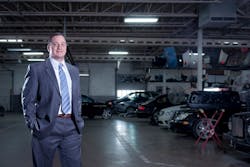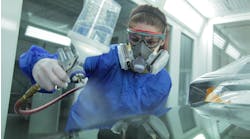There's no way two ways about it, says Eric McKenzie: pre- and post repair diagnostic scans are essential. Beyond the numerous position statements released by OEMs in 2016 effectively mandating scanning, McKenzie says that more than anything, it comes down to a safety issue—for both consumers and shops.
“Every time you disconnect the battery, it adds something to the fault memory and we have to clear fault memory,” he says. “It may say that nothing else further needs to be done, but at least the vehicle is back to where it was before the collision when it had no soft codes. In 80 percent of the cases, during that scan, we find there are additional items that need to be taken care of. A lamp needs to be calibrated, a seat belt needs to be deployed. There are a whole litany of things we’ll discover during that scan.”
While ensuring pre-accident condition is of paramount importance to the staff at Park Place Dealerships in Dallas, where McKenzie heads the collision department, he says another issue with not scanning vehicles is that the issues that were missed generally wouldn’t come up until a significant number of miles had been put on the vehicle.
“We would have clients pop up a week later. We’d act surprised but little did we know that there was an issue before,” he says. “There wasn’t a light on at the time.”
In an effort to both satisfy OEMs and ensure repair quality, McKenzie says the decision was clear: implement pre- and post-repair diagnostic scans as a best practice. The concern, however, was how to get both staff and insurers on board.
THE STARTING POINT
Beginning in summer 2016, a number of OEMs began releasing position statements mandating pre- and post-repair diagnostic scans to determine if any diagnostic trouble codes (DTCs) are present both before and after the repair. Many newer vehicles have electronic control modules, actuators, sensors or wiring that could possibly be damaged in the event of a collision. The damage may cause these electronic systems to perform incorrectly following the repair, and not all of the systems illuminate a malfunction indicator light on the dashboard. In addition, safety and driver assistance systems also required inspection, calibration and aiming after the repair, according to several of the statements.
In those statements, all the OEMs agreed that scanning is a quality issue for both car manufacturers, consumers, collision repairers and insurers, and that the only way to definitively identify damage is with a pre-repair scan.
THE IMPLEMENTATION
Park Place achieved its first collision repair certification in 1998 with Mercedes-Benz and has since added certifications as either the programs have become available or the dealership has added brands. That includes Volvo, Rolls-Royce, Nissan, Bentley, Porsche, Maserati and Honda certifications.
And while Park Place always made it a best practice to scan vehicles that had dash lights illuminated, it wasn’t consistently scanning every vehicle that came through the shop, McKenzie says. That changed, however, the second the first OEM released a position statement.
“We got the statement from Mercedes, and I met with my managers and we all agreed that the type of vehicles we work on are so advanced that let’s take it a step further. Is there a vehicle that we fix that doesn’t need to have that done to make sure everything associated with the repair is OK?” he says. “There are a whole litany of things we’ll discover during that scan. I just made it a best practice for all of our locations to do it for every vehicle every single time.”
While McKenzie was confident in his decision to scan every vehicle, every time, the decision also opened up his shop to a whole host of potential problems: Purchasing scan tools, getting reimbursed from insurers and implementing the process into his workflow.
PROCESS:
Park Place has dedicated mechanics at each of its collision centers, and those mechanics now perform a post-repair scan on every single vehicle. Pre-repair scans, which the mechanics do as stipulated by the OEM, but when needed, are kicked off by the body tech, who will let the mechanical tech know during the repair planning process that the pre-repair scan is needed.
PAY:
When it comes to paying technicians, McKenzie determined that mechanics would be paid half an hour of mechanical labor for pre-repair scans and an hour for post-repair scans. If recalibration is necessary, additional time is added.
“The pre-scan isn’t as involved because it’s just tell you what needs to be replaced,” he says. “The post scan you actually have to go through multiple screens and clear things out or dial into the network computer. There’s a lot more involved in the end and that’s just the scan.”
EQUIPMENT:
McKenzie says dealer shops are at an advantage because they have a firm grasp on their work mixes. Park Place’s collision centers have an OEM scan tool for each of their brands and a Matco tool that scans codes on most other vehicles. If that tool isn’t able to clear or scan everything—a rare occurrence—the mechanic will bring the vehicle to the dealership’s service center.
CHARGING/REIMBURSEMENT:
Park Place charges for recalibration, and charges labor for the pre- and post-repair scans. When it comes to reimbursement, McKenzie says that most insurers have been surprisingly receptive—as long as proper documentation is shown.
“There was a little bit of resistance from insurers because it was so new,” he says. “But as we’ve explained what it’s for and what we’re doing, they’re all OK with it.”
McKenzie says that positions statements that are especially clearly written are especially effective for reimbursement. Insurance companies frequently poke holes in position statements with vague terminology—such as “recommend” or “suggest”—he says, which is why it’s especially important to work with OEMs to craft strong position statements. Not every one of Park Place’s brands have released a position statement, and in those cases, McKenzie says he will utilize the position statements from other brands as leverage.
“What we’ll say to them is, ‘Just because it’s not in print from this OEM, can you tell me what’s different about this car that the other OEMs would require it and this one wouldn’t?’” he says. “What has worked in most cases is if we take a photo while we’re scanning and clearing fault codes, some can print or pop up on the screen. As long as we have evidence that codes need to be cleared, they’ll pay for it.”
THE RESULTS
McKenzie says that pre- and post-repair scans have both boosted quality, ensured safe repairs and increased efficiency by detecting damage ahead of time.
“It’s definitely helped us with issues that used to pop up,” he says. “And if you’re adding an hour of mechanical time based on that, the revenue that goes with it is nice but the bottom line is back with all the safety functions. To me the revenue is a side note. It’s operating with all the safety functions.”
McKenzie has had to add staff in his facilities since then; one extra mechanic at each facility to account for the additional hours of labor.
“As some of my production managers pointed out, we’re adding 600 hours of labor. It’s going to be a lot more time,” he says. “We need to prepare them for the procedures.”




